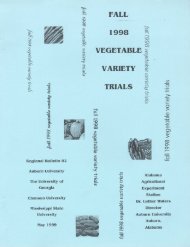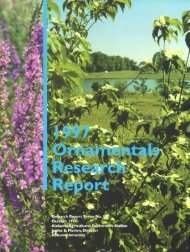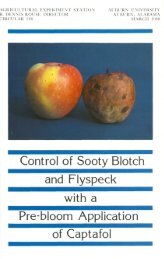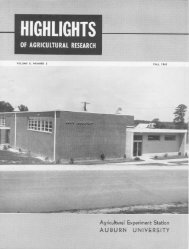MARKETING CHRISTMAS TREES - Auburn University Repository
MARKETING CHRISTMAS TREES - Auburn University Repository
MARKETING CHRISTMAS TREES - Auburn University Repository
Create successful ePaper yourself
Turn your PDF publications into a flip-book with our unique Google optimized e-Paper software.
22<br />
ALABAMA AGRICULTURAL EXPERIMENT STATION<br />
Oklahoma - "Douglas fir . . . can expect an increasing amount<br />
of competition."<br />
Missouri - "Many of our farmers are beginning to grow Jack<br />
and Scotch pine for local (Christmas tree) markets."<br />
SUMMARY<br />
The Christmas tree market of the United States is expanding<br />
slightly faster than the population is increasing. Production and<br />
imports of Christmas trees were estimated to be 15 per cent higher<br />
in 1955 than in 1947 on a per capita basis.<br />
Much of the South's Christmas tree market was supplied by<br />
trees imported from Canada and northern states in 1956, even<br />
though the South has a number of advantages in growing and<br />
harvesting trees that are adapted for use as Christmas trees.<br />
This study was designed to determine the kind, size, and quality<br />
of Christmas trees marketed in Alabama and the methods of marketing,<br />
together with prices obtained and problems met in marketing<br />
these trees.<br />
Christmas trees sold in Alabama far exceeded the number "produced"<br />
and offered for sale in 1956.<br />
Alabama's markets for Christmas trees were generally poorly<br />
organized with many sellers of various ages, interests, and abilities<br />
taking part. Chain stores, some independent stores, and some<br />
civic groups had much better organization than did the bulk of<br />
retailers.<br />
Locally produced trees plus those imported from an adjoining<br />
state accounted for only a little over a third of the tree offerings<br />
recorded. The remainder came from northern states and from<br />
Canada.<br />
Mass sellers, including chain stores and civic organizations,<br />
relied almost entirely on shipped in trees which were graded by<br />
size and bundled or cartoned. Thus they were arranged for a<br />
degree of orderly handling, pricing, and selling. Individual sellers<br />
tended to handle locally produced or "short haul" imported<br />
trees, which were neither graded nor sorted.<br />
Mobile depended largely on imported spruce or fir, whereas<br />
Montgomery obtained about three-fourths, Gadsden about onehalf,<br />
and Birmingham about one-third from such sources.<br />
Complaints on a quality basis were not recorded for ornamentals;<br />
for other trees of the spruce-fir group, complaints centered
















